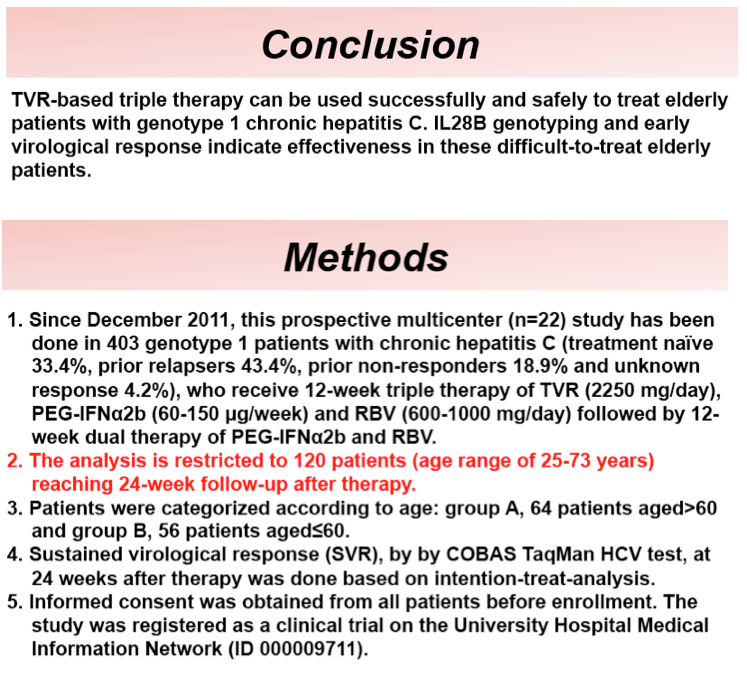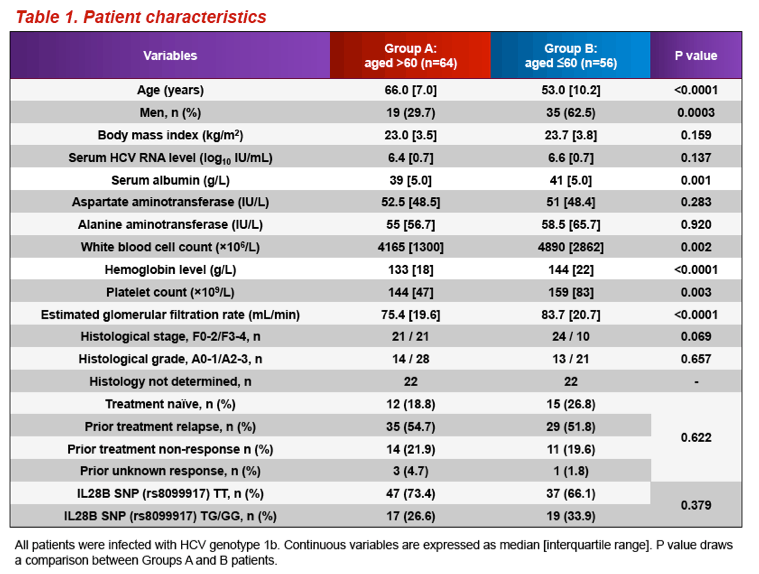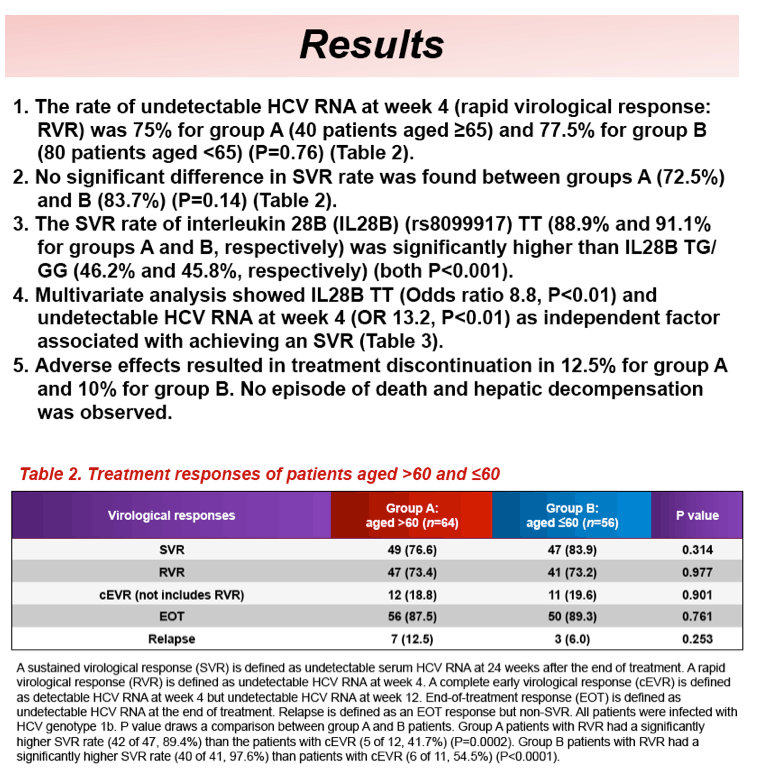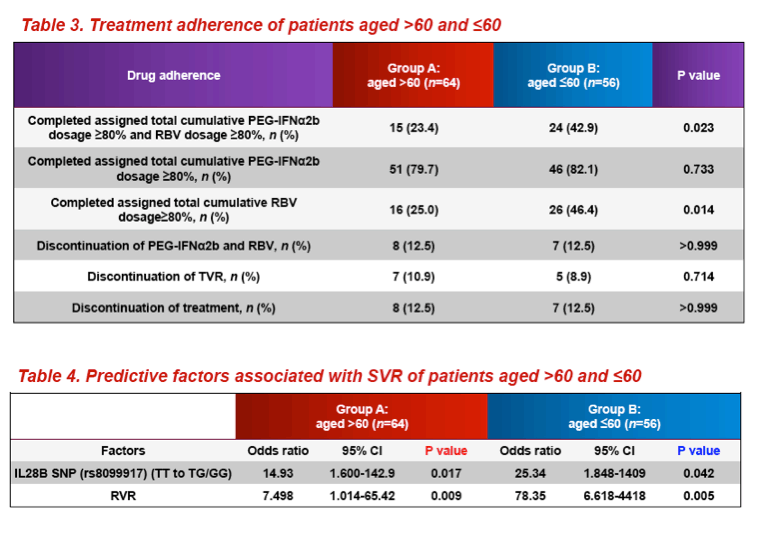 |
 |
 |
| |
Telaprevir-based triple therapy for elderly patients with genotype 1 chronic hepatitis C
|
| |
| |
Reported by Jules Levin
IDSA Oct 2-6 2013, San Francisco, CA
"TVR-based triple therapy can be used successfully and safely to treat elderly patients with genotype 1 chronic hepatitis C. IL28B genotyping and early virological response indicate effectiveness in these difficult-to-treat elderly patients."
Norihiro Furusyo MD. PhD., Eiichi Ogawa MD. PhD., Masayuki Murata MD. PhD., Hiroaki Ikezaki MD., Satoshi Hiramine MD., Jun Hayashi MD. PhD.
Department of General Internal Medicine, Kyushu University Hospital, Fukuoka, Japan
Introduction & AIM
In the United States, Canada, the European Union, and Japan, telaprevir (TVR), a hepatitis C virus (HCV) nonstructural 3/4A (NS3/4A) protease inhibitor, has been approved for the treatment of chronic hepatitis C genotype 1 since 2011 and represents a new class of small molecules that are direct-acting antiviral agents (DAA) for reflecting HCV replication. TVR-based triple therapy, combined with pegylated-interferon α (PEG-IFNα) and ribavirin (RBV), has resulted in an improved SVR rate, when compared to PEG-IFNα monotherapy and PEG-IFNα plus RBV dual therapy.
We have reported our experience of treating a cohort of chronic hepatitis C patients using combination with peginterferon-alpha-2b (PEG-IFNα2b) plus ribavirin (RBV) in which over 1,200 patients were analyzed (Furusyo N, et al. J Gastroenterol Hepatol 2008; 23: 1094-104: Ogawa E, et al. J Hepatol 2013; 58: 495-501). Significantly lower virological response and higher discontinuation of treatment due to adverse effects were found in elderly patients than the younger.
Earlier studies of TVR-based regimens for chronic hepatitis C have not shown any correlation between age and the virological outcome.
Furthermore, there are no data regarding differences in factors predictive of SVR by older and younger patients. For this reason, we conducted a prospective, multicenter study to investigate the efficacy and safety of TVR-based triple therapy for older patients with chronic hepatitis C.
Program Abstract
Background: We have reported our experience of treating a cohort of chronic hepatitis C patients using combination with peginterferon-alpha-2b (PEG-IFNα2b) plus ribavirin (RBV) in which over 1,200 patients were analyzed. Significantly lower virological response and higher discontinuation of treatment due to adverse effects were found in elderly patients than the younger. The aim of this study was to evaluate the efficacy and tolerability of triple therapy with telaprevir (TVR), PEG-IFNα2b and RBV in chronic hepatitis C patients aged 65 years and older.
Methods: This prospective multicenter (n=22) study was done in 403 genotype 1 patients with chronic hepatitis C (treatment naïve 33.4%, prior relapsers 43.4%, prior non-responders 18.9% and unknown response 4.2%) who receive 12-week triple therapy of TVR (2250 mg/day), PEG-IFNα2b (60-150 μg/week) and RBV (600-1000 mg/day) followed by 12-week dual therapy of PEG-IFNα2b and RBV. Serum HCV RNA levels were monitored by COBAS TaqMan HCV test. The analysis is restricted to 120 patients (age range of 25-73 years) reaching 12-week follow-up after therapy. Sustained virological response at 24 weeks after therapy (SVR) was done based on intention-treat-analysis.
Results: The rate of undetectable HCV RNA at week 4 was 75% for group A (40 patients aged ≥65) and 77.5% for group B (80 patients aged <65) (P=0.76). No significant difference in SVR rate was found between groups A (72.5%) and B (83.7%) (P=0.14). The SVR rate of interleukin 28B (IL28B) (rs8099917) TT (88.9% and 91.1% for groups A and B, respectively) was significantly higher than IL28B TG/GG (46.2% and 45.8%, respectively) (both P<0.001). The multivariate analysis showed IL28B TT (Odds ratio 8.8, P<0.01) and undetectable HCV RNA at week 4 (OR 13.2, P<0.01) as independent factor associated with SVR. Adverse effects resulted in treatment discontinuation in 12.5% for group A and 10% for group B. No episode of death and hepatic decompensation was observed.
Conclusion: TVR-based triple therapy can be used successfully and safely to treat elderly patients with genotype 1 chronic hepatitis C. IL28B genotyping and early virological response indicate effectiveness in these difficult-to-treat elderly patients. (Co-research group: The Kyushu University Liver Disease Study (KULDS) Group)




|
| |
|
 |
 |
|
|